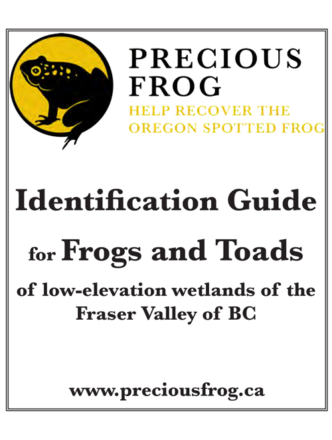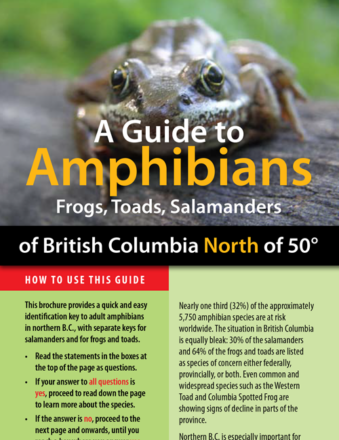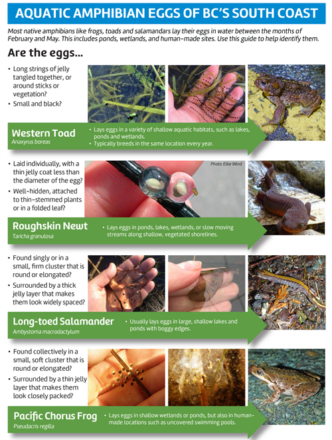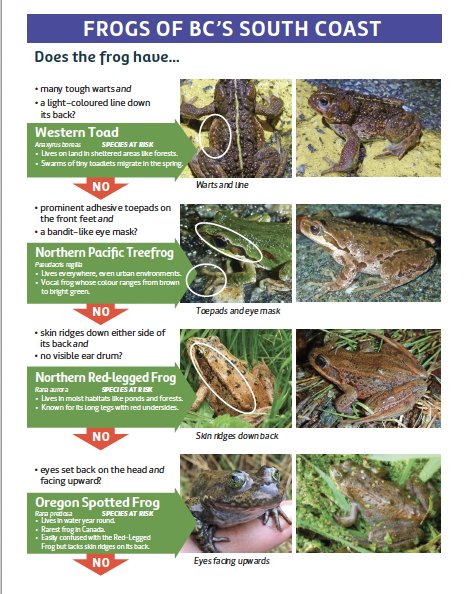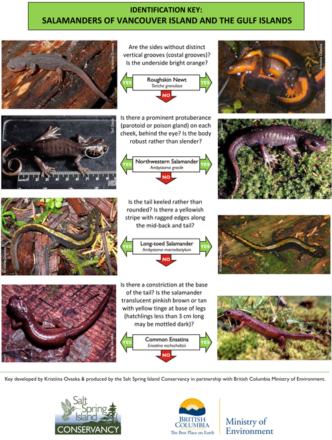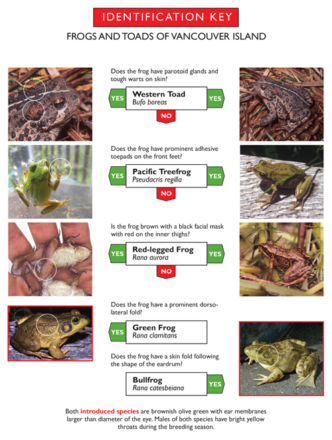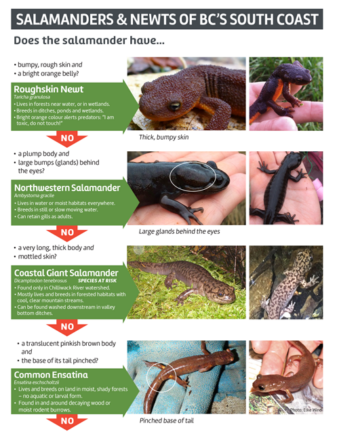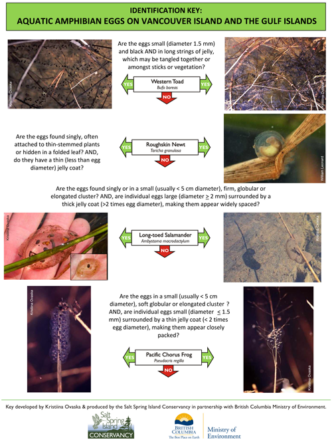Amphibian Identification Keys
HOW TO USE
1a. Pupil of eye vertical when contracted…………………2
1b. Pupil of eye horizontal when contracted…………………4
2a. Sharp-edged, horny spade on underside of foot, body squat and toad-like…………………Great Basin Spadefoot (Spea intermontana)
2b. No spade on sole of foot, male with tail-like copulatory organ…………………3
3a. Fine black speckles on dorsal and ventral surfaces, found in extreme southeastern British Columbia only…………………Rocky Mountain Tailed Frog (Ascaphus montanus)
3b. No fine black speckles on dorsal and ventral surfaces, found in the Coast range…………………Coastal Tailed Frog (Ascaphus truei)
4a. Parotoid glands and rough warts present, body squat…………………Western Toad (Anaxyrus boreas)
4b. No parotoid glands or warts present, skin smooth or with scattered tubercles…………………5
5a. Conspicuous adhesive toepads present, dark eye stripe ending at shoulder…………………Pacific Treefrog (Pseudacris regilla)
5b. Toepads absent or inconspicuous…………………6
6a. Body elongate with dark side stripes extending to groin, three dorsal stripes or series of spots also present…………………Boreal Chorus Frog (Pseudacris maculata)
6b. Dark side and dorsal stripes absent, dorsolateral folds and/or skin fold around ear membrane present…………………7
7a. Large rounded spots with light halos present on a green or brown background, belly white, dorsolateral folds present…………………Northern Leopard Frog (Lithobates pipiens)
7b. No large, rounded spots on back…………………8
8a. Colour green or olive-green, no dark facial mask present. Adult males with deep yellow throats and ear membranes larger than diameter of eye…………………9
8b. Colour brown or tan, may have black, irregular spots on back, dark facial mask more or less obvious…………………10
9a. Dorsolateral folds present…………………Green Frog (Lithobates clamitans)
9b. Dorsolateral folds absent, skin fold around car membrane present…………………American Bullfrog (Lithobates catesbeianus)
10a. Distinct, black facial mask present, no black dorsal spots, white belly, white middorsal stripe may be present…………………Wood Frog (Lithobates sylvaticus)
10b. Red, orange or yellow colouration underneath especially in older individuals, dark spots present on back, facial mask present but not intensely dark…………………11
11a. Eye not upturned, red-coloured underparts, bones of lower leg may be visible through skin, area of green in groin…………………Northern Red-legged Frog (Rana aurora)
11a. Eye upturned, salmon colour on white background on belly and under legs, distinct dark spots on back, no green area in groin…………………12
12a. Inconspicuous grey mottling on belly, British Columbia lower mainland only…………………Oregon Spotted Frog (Rana pretiosa)
12b. No grey mottling on belly, British Columbia other than lower mainland…………………Columbia Spotted Frog (Rana luteiventris)

Reference:
Matsuda BM, Green DM, Gregory PT. 2006. Amphibians and Reptiles of British Columbia. Victoria (BC): Royal BC Museum. 266 p.
HOW TO USE
1a. Skin rough and tuberculate, belly bright orange, no obvious costal grooves…………………Rough-skinned Newt (Taricha granulosa)
1b. Skin smooth, costal grooves evident…………………2
2a. Nasolabial groove running down from each nostril (may be difficult to see in some species), parasphenoid teeth present…………………3
2b. No nasolabial grooves or parasphenoid teeth…………………7
3a. Yellow, orange or red dorsal stripe continuing to tip of tail…………………4
3b. No dorsal stripe…………………5
4a. Smooth edged red, orange, or yellowish dorsal stripe continuing to tip of tail, 15 costal grooves…………………Western Red-backed Salamander (Plethodon vehiculum)
4b. Irregular yellow to orange-red dorsal stripe broken into patches on the head, 14 costal grooves…………………Coeur d’Alène Salamander (Plethodon idahoensis)
5a. Tail constricted at base, yellow colour at limb bases, no markings on back, 12 costal grooves…………………Ensatina (Ensatina eschscholtzii)
5b. Tail not constricted at base, no yellow at limb bases, 15 costal grooves…………………6
6a. Mottled colour pattern, square toe-tips…………………Wandering Salamander (Aneides vagrans)
6b. Uniform gray or charcoal colour, rounded toe-tips…………………Western Red-backed Salamander (Plethodon vehiculum)
7a. Irregular green or yellow dorsal stripe breaking up on the head and tail, white speckles on sides and belly, 12 costal grooves, second toe from the outside on each hind foot longer than other toes…………………Long-toed Salamander (Ambystoma macrodactylum)
7b. No dorsal stripe, length more than 120 mm…………………8
8a. Blotched yellow (or white) and black pattern, foot tubercles present, 13 costal grooves…………………Western Tiger Salamander (Ambystoma mavortium)
8b. Foot tubercles absent…………………9
9a. Colour dark brown to black or grey with or without black specks, parotoid glands and glandular ridge on tail present, 10 to 12 costal grooves…………………Northwestern Salamander (Ambystoma gracile)
9b. Marbled brown pattern, no parotoid glands or glandular ridge on tail, 12 costal grooves…………………Coastal Giant Salamander (Dicamptodon tenebrosus)
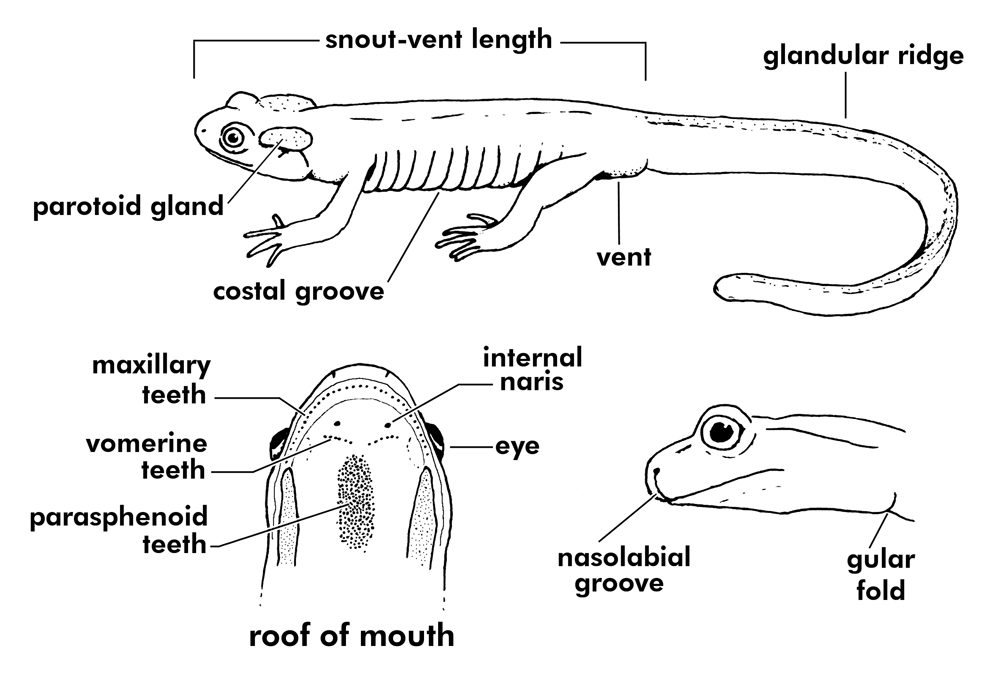
Reference:
Matsuda BM, Green DM, Gregory PT. 2006. Amphibians and Reptiles of British Columbia. Victoria (BC): Royal BC Museum. 266 p.
What is the difference between a tadpole and a larva?
All of BC’s frogs and toads lay their eggs in water, and they hatch as tadpoles. They initially have small gills, but these structures are no longer visible after a few days, and then the tadpoles tend to simply look like a body with a tail.
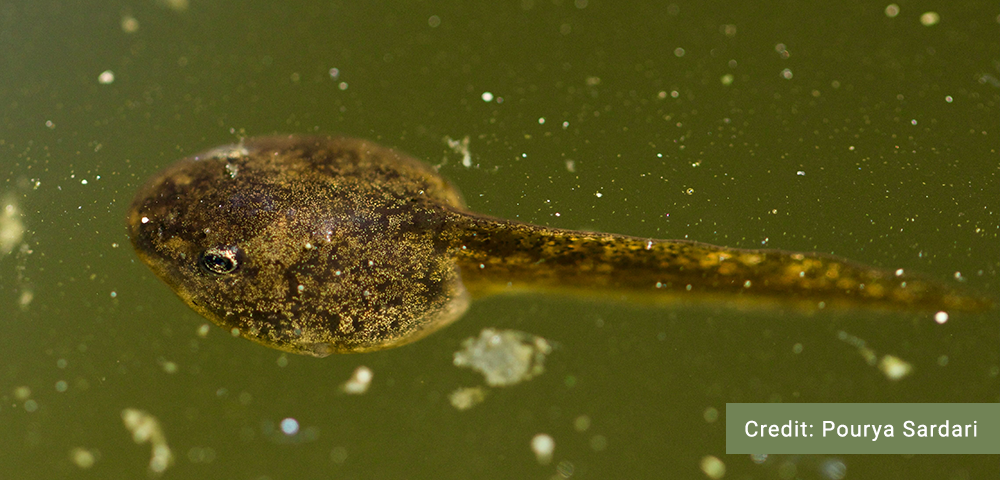
Salamander larvae are a bit different:
After aquatic salamanders lay their eggs in water, the young hatch as aquatic larvae. Hatchlings will initially lack legs, but gills will be visible. Legs begin to develop quickly, so within a few weeks the young animals have four legs and gills. Some salamanders stay in their larval form for their entire lives, which is called neoteny. These individuals become sexually mature without metamorphosing. In BC, neoteny can occur in Coastal Giant Salamanders, Western Tiger Salamanders, Northwestern Salamanders, and Rough-skinned Newts.
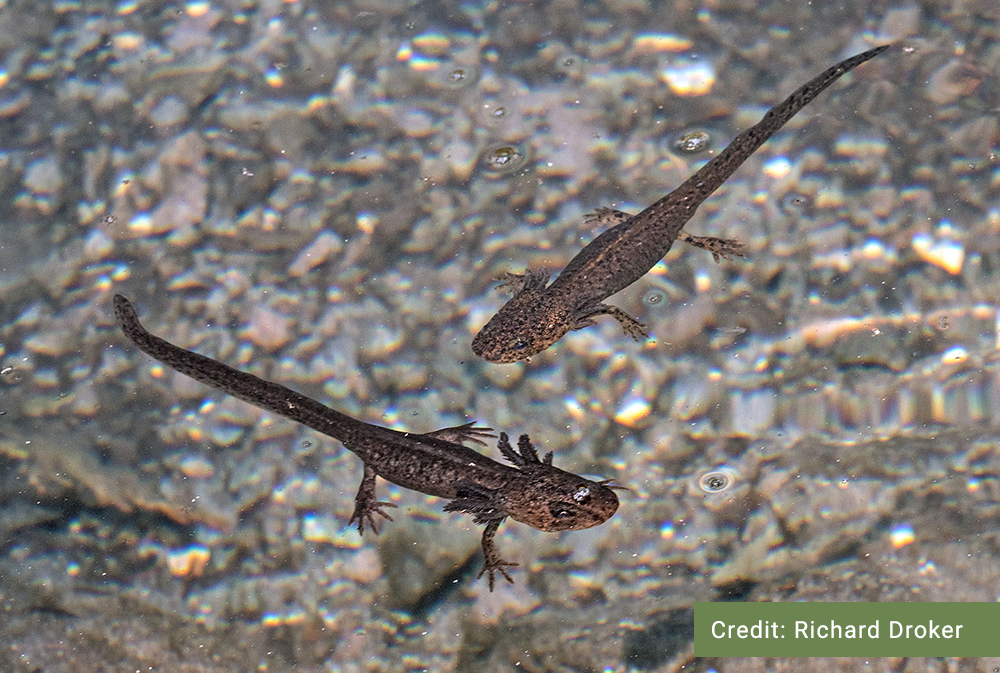
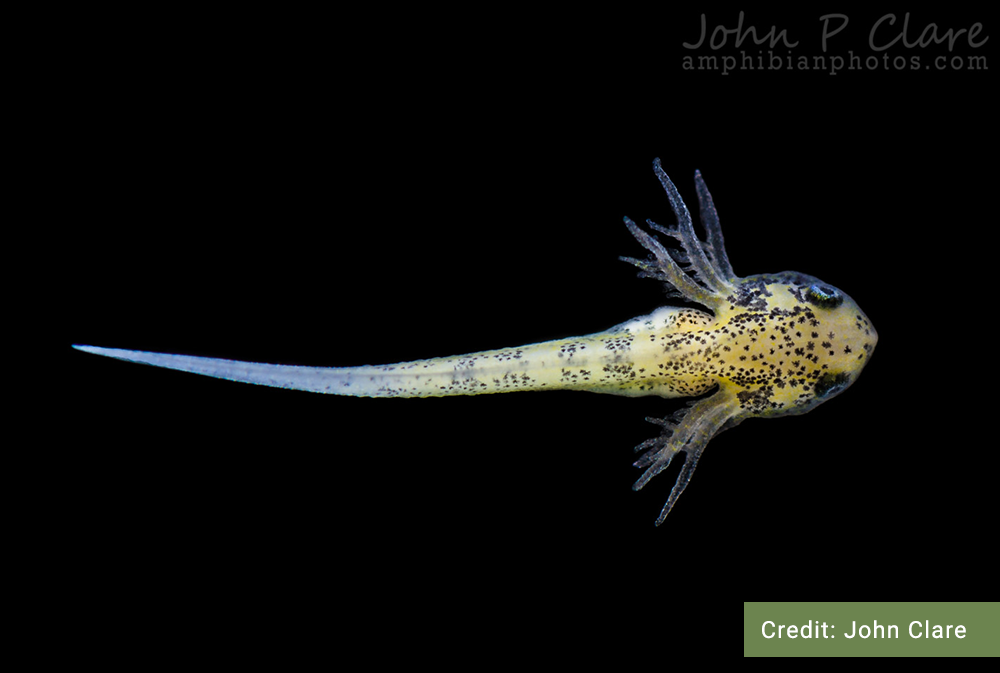
Telling different species of frogs/toads and salamanders apart when they are in their tadpole and larva forms can be very challenging. Here we provide a few distinguishing features that you can use to identify species in a certain area. If you would like a more extensive guide, we suggest using a copy of Corkran and Thoms’ Amphibians of Oregon, Washington and British Columbia: A Field Identification Guide (2020).
BC Tadpoles
Vancouver Island and Gulf Islands:
If the tadpole is black in colour, has a square-shaped snout, and occurs in large quantities, it is a Western Toad.
If the body is short and round and varies in colour, it is either:
- Pacific Treefrog – eyes are spaced far apart and modify body outline.
- Northern Red-legged Frog – eyes are located centrally and do not interrupt body outline.
If the tadpole has a long body and a large tail trunk that is thicker than it is tall at the base, it is either:
- American Bullfrog – body is shaped like an arrow-head, has sharp-edged black spots, and can be very large (up to 60 mm SVL).
- Green Frog – body is oval-shaped, spots have blurred edges, and are small (30 mm SVL or less).

Coast:
If the tadpole is in a stream AND in the Coastal Mountains, it is a Coastal Tailed Frog.
If the tadpole is black in colour, has a square-shaped snout, and occurs in large quantities, it is a Western Toad.
If the body is short and round and varies in colour, it is either:
- Pacific Treefrog – eyes are spaced far apart and modify body outline.
- Northern Red-legged Frog – eyes are located centrally and do not interrupt body outline.
If the tadpole has a long body and a large tail trunk that is thicker than it is tall at the base, it is either:
- American Bullfrog – body is shaped like an arrow-head, has sharp-edged black spots, and can be very large (up to 60 mm SVL).
- Green Frog – body is oval-shaped, spots have blurred edges, and are small (30 mm SVL or less).
If the tadpole has a long tail (2x the length of the body) that is taller than it is thick at the base, a tall dorsal fin that arches steeply up from near the base of the tail, AND is in the Fraser Valley, it is an Oregon Spotted Frog.
Interior:
If the tadpole is in a stream AND in the Coastal Mountains, it is a Coastal Tailed Frog.
If the tadpole has gold flecks or patches scattered all over and forming a “Y” across the body, and the spiracle is low on the side (touching belly outline), it is a Great Basin Spadefoot.
If the tadpole’s eyes are spaced far apart and modify the body outline, it is either a:
- Pacific Treefrog – eyes are spaced far apart and modify body outline.
- Northern Red-legged Frog – eyes are located centrally and do not interrupt body outline.
If the tadpole’s body is globular, its tail trunk is dark along top and light underneath, and its mouth has bars of gold flecks that radiate out like whiskers, it is a Wood Frog.
If the tadpole has a globular body, a long tail (2x the length of the body), and a tall dorsal fin that arches steeply up from near the base of the tail, it is a Columbia Spotted Frog.
Rocky Mountains:
If the tadpole is in a stream, it is a Rocky Mountain Tailed Frog.
If the tadpole has a globular body, a long tail (2x the length of the body), and a tall dorsal fin that arches steeply up from near the base of the tail, it is a Columbia Spotted Frog.
If the tadpole’s body is short and round, its tail trunk is dark along top and light underneath, and the mouth has bars of gold flecks that radiate out like whiskers, it is a Wood Frog.
If the tadpole’s belly either has silver blotches OR is transparent so that guts are easily visible, AND is in the Creston Valley, it is a Northern Leopard Frog.
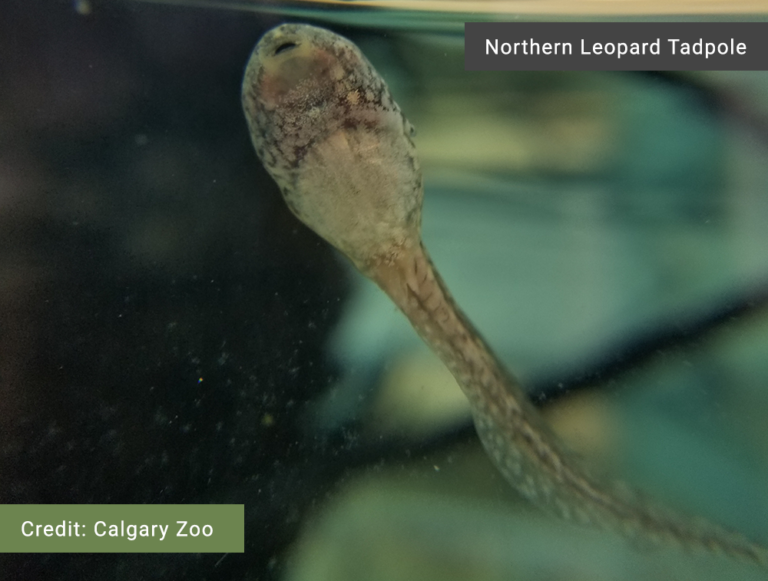
B.C. Salamander Larva
NOTE: Only five out of the nine salamander species in BC have an aquatic larval form. The other four species (Coeur d’Alene Salamander, Wandering Salamander, Western Red-backed Salamander, and Ensatina) are fully terrestrial and lay their eggs on land; the young complete most of their development within the egg and hatch as small versions of the adult form.
If the larvae is in a stream AND is in the Chilliwack River Valley, it is a Coastal Giant Salamander.
If you are on the coast (including Vancouver Island and the Gulf Islands), there are three possible species of larvae you might encounter:
- Rough-skinned Newt – Larvae are translucent tan and can be distinguished by a narrow snout and gills that have dark speckles, that often droop down at the tip; yellow dots in older larvae.
- Northwestern Salamander – Larvae are olive-brown and can be distinguished by a blunt snout and gills that are plume-like; there are no yellow dots along its sides.
- Long-toed Salamander – Larvae are brown-grey and can be distinguished by a broad snout and gill stalks that appear in orderly fashion; there are no yellow dots along its sides.
If you are in or around the South Okanagan region, there are two species of larvae you might encounter:
- Western Tiger Salamander – Larvae have large bodies (16-150 mm SVL) and gill stalks (longer than head length and very wide).
- Long-toed Salamander – Larvae are smaller (10-35 mm SVL) and have shorter gill stalks.
If you are elsewhere in the interior of the province, you saw a Long-toed Salamander larva.


